The Extraordinary Alexandra David-Néel: First European Woman to Travel to the Forbidden City of Lhasa
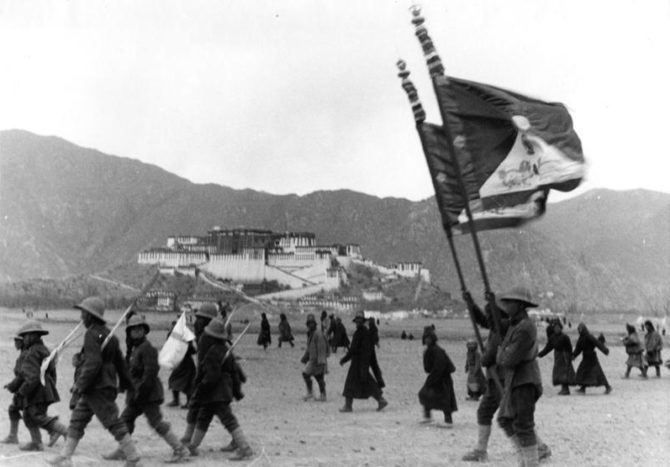
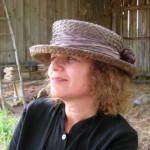
- SUBSCRIBE
- ALREADY SUBSCRIBED?
BECOME A BONJOUR PARIS MEMBER
Gain full access to our collection of over 5,000 articles and bring the City of Light into your life. Just 80 USD per year.
Find out why you should become a member here.
Sign in
Fill in your credentials below.
French explorer, author, and Buddhist scholar, Alexandra David-Néel led a full and exceptional life. In 1924, at the age of 55, she was the first European woman to cross the Trans-Himalayas in the dead of winter to reach the forbidden city of Lhasa in Tibet. Scaling 19,000-foot peaks without supplementary oxygen and wearing crude leather boots. During her life, which spanned almost 101 years, she wrote more than 30 books on eastern religions and remains today the most authoritative source on Tibetan Buddhism.
The only child of an unfortunate marriage, Louise Eugénie Alexandrine Marie David was born on October 24, 1868, in Saint-Mandé, Val-de-Marne, in between the Bois de Vincennes and the defensive wall surrounding Paris. Her father, Louis David (a distant relative and namesake of the renowned artist, Jacques-Louis David) was a Hugenot Freemason, left-leaning journalist and teacher, and her mother, Alexandrine Borghmans, a Catholic native of Belgium.
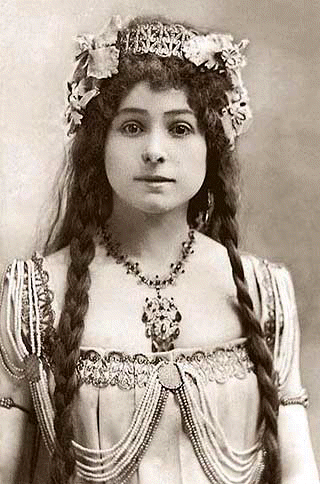
Alexandra David-Néel in 1886
From her earliest memories Alexandra was bedeviled by wanderlust. As a child, her father used to take her to the Gare de Vincennes and Gare de Lyon to watch trains come and go. They would walk together through the ongoing demolition created by Baron Haussmann’s redesign of Paris, the city from which she longed to escape. She became an avid reader often losing herself in the imaginary worlds of science fiction and visionary ascetic saints. Always wanting to be somewhere other than where she was, she longed for adventure: “I learned to run before I could walk!”
At the age of 15 while spending school holidays with her parents at the Belgian city of Ostende on the coast of West Flanders, Alexandra ran away and reached the port of Vlissingen in the Netherlands before turning back. In her 17th year, with the maxims of the stoic philosopher, Epictetus, in hand, she took a train destined for Switzerland and managed to walk across the Saint Gotthard Pass in the Swiss Alps to Lake Maggiore in Italy. A year later she tied all of her possessions onto the handlebars of her bicycle and set off for a discovery tour of Spain. The following year under pressure from her father, she enrolled at the Royal Conservatory in Brussels to study music and voice. Good enough to become a touring opera singer, she traveled to French Indochina, the Middle East and North Africa on and off for 14 years.
Indifferent to her bourgeois upbringing, she was intuitively drawn to Buddhist mythology, particularly the life of Siddhartha Gautama. In her room she had both a figure of Christ and the Buddha. Then in her early 20s, Alexandra traveled to London to study Theosophy with Madame Blavatsky while honing her English language skills. When the Guimet Museum of Asian Art opened in Paris she returned and steeped herself in Buddhist sacred art, spending all of her free time there. Concurrently, she audited courses in Hindu philosophy and Chinese Taoism at the College of France and the Sorbonne. At that time women were not permitted as degree-earning students. Undaunted, she became a Buddhist, in 1889 and made her first spiritual journey to India.
In 1900, during her last touring opera engagement in Tunisia, Alexandra met the wealthy Philippe Néel de Saint-Sauveur, manager and engineer of the local railway system. They soon became lovers, then were married in 1904, when she was 36. Seven years later Alexandra returned to India. She and Philippe started an extensive correspondence. Though they lived apart for the rest of his life, he remained supportive, both financially and emotionally, until his death in 1941.
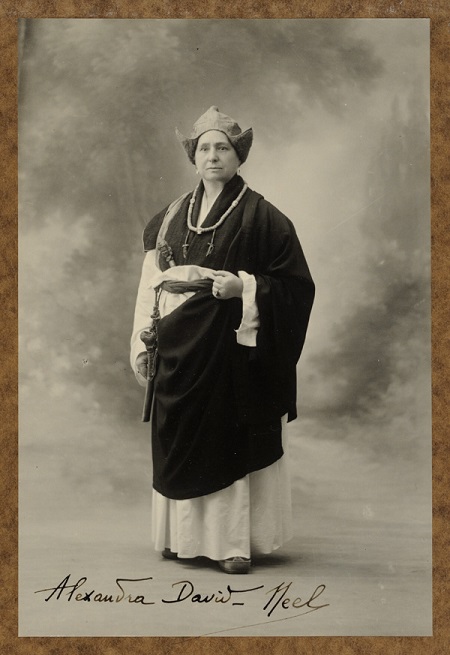
1933, Preus museum
Rarely constrained by the deference expected of her gender in either Western or Eastern cultures, Alexandra studied Sanskrit in Benares, India, the Hindu holy city. To further her study of Buddhism the following year she traveled to the royal monastery of Sikkim, where she befriended Sidkeong Tulku Namgyal, the spiritual leader of the country. Their mutual understanding and attraction was immediate and he became the great passion of her life. Sidkeong organized a one-week expedition for her into the high mountains of Sikkim with the Lama Kazi Dawa Samdup as a guide and interpreter. Upon returning she sought and received an audience with the 13th Dalai Lama (1876–1933), the first European woman to be accorded this high honor. Born Thubten Gyatso, the Dalai Lama had recently fled Tibet when Chinese troops invaded. Alexandra surprised him by telling him she was the only Buddhist in Paris, and that the Gyatcher Rolpa, a sacred Tibetan book, had been translated by Phillippe-Édouard Foucaux, a professor at the College of France. She received his blessing, and later followed his advice to learn Tibetan.
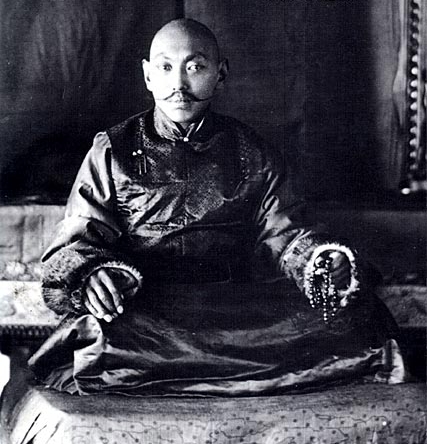
Thubten Gyatso, 13th Dalai Lama 1910, Author: Thomas Paar
For further enlightenment, Alexandra became a disciple of Gomchen of Lachen, the abbott of a small monastery in a mountain village near the Tibetan border just outside of Sikkim, with whom she spent two years. It was there she met her future traveling companion, 15-year-old Lama Aphur Yongden, whom she would adopt in 1929. Locals believed Gomchen could fly through the air, kill men with a glance and command demons. His occult knowledge formed the basis of her 1929 book, Magic and Mystery in Tibet. From him Alexandra learned Tibetan. The disciplines Gomchen taught her such as tummo, a breathing practice to create heat, helped her survive the Himalayan snows during her journey to Lhasa, Tibet’s capital. At the end of her retreat she learned that Sidkeong had died mysteriously, presumably poisoned.
In 1916, Alexandra and Yongden illegally crossed the border into Tibet, hoping to reach its capital, Lhasa. The country had been closed to foreigners for several decades by then because its leaders feared the encroachment of the Russian and British Empires, which would have destroyed its unique character. British colonial authorities, who had jurisdiction over Sikkim, soon learned of the transgression and attempted to deport Alexandra and Yongden back to France. Unable to return to Europe due to the outbreak of World War I, they fled and traveled over 5,000 miles by yak, mule and horse to Japan, Korea, Mongolia, and China, finally arriving at Kumbum Monastery (considered the birthplace of Tibetan Buddhism) in Tibet in 1921. Immersing themselves in the study of rare manuscripts for three years, they painstakingly translated the Prajnaparamita (Sanskrit doctrines dating from the 2nd to the 6th centuries AD), the famous Heart Sutra, into French.
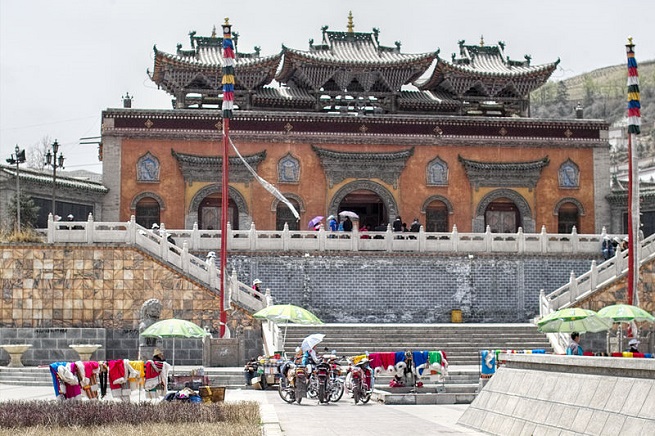
Kumbum Monastery, photo: ArishG
The story of Alexandra and Yongden’s epic journey from the Monastery to the forbidden city of Lhasa in 1924 is almost too incredible to believe and too fascinating to summarize. After spending two months hidden from detection, they descended to India, proclaiming their triumph before British officials in Calcutta, then sailed for France. The magazine articles she wrote about this journey later became the book, My Journey to Lhasa: The Personal Story of the Only White Woman Who Succeeded in Entering the Forbidden City, which caused a sensation when it was published in 1927. The New York Times reviewer commented, “…(Alexandra’s) journey reveals amazing and almost incredible powers of physical endurance. In peasant homes she slept on floors on greasy sackcloth and drank nauseating, evil smelling broths from her bowl that she must later cleanse, native fashion, by licking with her tongue.”
Alexandra was awarded the Gold Medal of the Geographical Society of France, and was subsequently named Chevalier of the French Legion of Honor. With the proceeds from her book sales she bought a house in Provence in the village of Digne-les-Bains. She and Yongden lived there in the house she named Samten Dzong (Fortress of Meditation). Over the ensuing years they continued to travel together. She wrote many more books, including Buddhism: Its Doctrines and Its Methods, published in the United States in 1939, and The Secret Oral Tradition in Tibetan Buddhist Sects, published by San Francisco’s City Lights Bookstore in 1964. Sadly, Yongden predeceased Alexandra, who passed away in 1969, just shy of her 101st birthday.
On Oct. 4, 2018, the Provençal village of Digne will celebrate the 150th anniversary of Alexandra David-Néel’s extraordinary life.
Lead photo credit : The Tibetan army waves the Tibetan flag at a military parade in Lhasa, 1938. German Federal Archive
More in Buddhism



REPLY